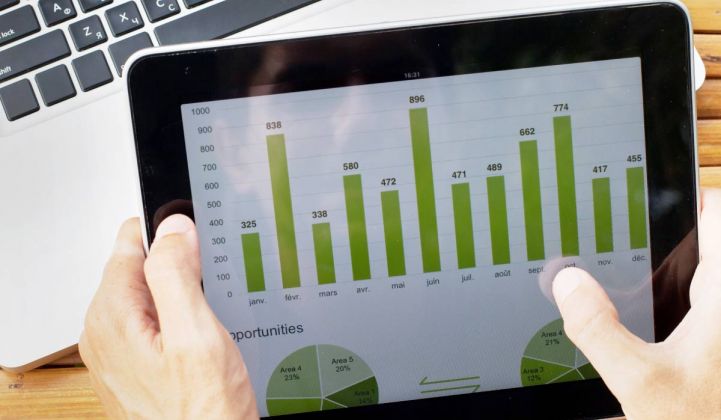The way enterprises buy and use energy is changing rapidly, driven by trends such as grid-scale and on-site renewable energy opportunities, changes to rate tariffs that may lead to time-of-use charges and higher monthly bills, and a variety of new data-driven technologies and service offerings from an ever-expanding number of vendors. Startups and innovators often are at the leading edge of these trends, selling directly to enterprises or through established service providers.
But even companies that offer highly differentiated solutions will find that there are many barriers to scaling a company in the energy industry. The smaller the firm, the harder it may be to overcome them.
One of the biggest and most consistent challenges for any energy firm is determining the fundamental metric for energy customers: actual consumption and demand of energy, in granular detail (monthly and even in 15-minute intervals, where available). This baseline data enables analysis and a way to evaluate "what-if" scenarios to determine the financial feasibility of many new energy solutions and services.
Some specific barriers to acquiring such data include the thousands of different domestic utility providers, no consistent standard data format among them, and various amounts and types of data offered by them. This makes it challenging for any firm to scale, even if its product delivers a 10x benefit to its users.
To overcome this foundational barrier, energy-data-as-a-service (EDaaS) provides a standard, continuous feed of energy data, from any utility, which enables energy solution and technology providers to focus their resources on innovating and differentiating their offerings. We examine several of the benefits EDaaS delivers to firms providing renewables, battery storage, and data-driven products and solutions.
1) Lower customer acquisition costs. There is a competitive environment for new energy economy providers, from solar to batteries to other information and data products. Vendors that can reduce the cost and time to acquire customers can differentiate in the market. If a year of historical energy data can be acquired quickly and for incremental cost, total customer acquisition costs could decline based on a higher conversion rate.
Actual energy-use data from each given prospect will enable vendors to model a more realistic and compelling business case. For example, if a solar firm wants to justify upfront costs or show the long-term value of energy bill reductions, actual historic bill data is better than averages and estimates. Many enterprises, even on a single corporate campus, may have multiple utility accounts, making it difficult for prospective vendors to acquire this information on their own. But EDaaS enables firms to deliver proposals to prospects in less time and convert more opportunities into new projects.
2) Establish an ongoing relationship with your clients. Once a new project is implemented, it is important for the provider to continue to maintain the relationship and ensure that the project is meeting the client’s expectations. A common method is to provide regular performance updates, and data-driven measurement and verification (M&V) is a trusted and standardized way to do so.
Because most enterprises look at energy projects through a financial ROI lens, access to energy bills and data are vital to prove the value. Especially if the project has visibility across the entire firm and up to the C-suite, solution providers that use actual energy data provide regular financial updates will be trusted and establish a strong rapport with their clients. This may also lead to positive referrals to new customers. Additionally, the data-driven view into project performance may lead to expansion opportunities throughout the organization.
3) Reduce investment risk. For institutional investors that fund renewable and energy-efficiency projects, increased data about historic and ongoing utility costs provides more visibility into project performance and reduces the risk of default. At a macro level, loan default risk can be predicted based on how much savings customers are getting from their solar and distributed energy systems. For example, if a homeowner realizes energy cost reductions each month, she will be more likely to continue to pay on the loan. Actual utility bill data can be used to understand these risks at a detailed level. Moreover, if the loans are being sold on the secondary market, utility bill data will provide additional confirmation of the lower default risk.
4) Serve the residential market. On the residential side, home automation is becoming a new battleground across cable and telecom companies, security providers and disruptive innovators. But many of these firms lack insight into the actual energy bills and true costs of energy. Knowing that the furnace is running overtime is useful, but being able to quantify it into actual dollars will compel action. There are a variety of services that could be provided on a home automation platform, and understanding current energy costs and potential savings will enable offerings to be marketed more specifically to those homeowners that need them.
Large, established players can also benefit from energy-data-as-a-service. The value propositions listed above will provide tangible benefits to even the largest of energy, financial and building services firms. In some cases, a large firm may have the resources to build energy data acquisition capabilities, but in light of a commercially available solution, such an effort may be a poor use of resources. Just as many large and small firms are moving to software-as-a-service instead of procuring and maintaining software on their own in-house servers, energy firms small and large should consider subscribing to EDaaS for consistent and scalable data to support their growth and operations.
***
Sanjoy Malik is the CEO of Urjanet, which helps organizations reduce their energy use and carbon footprint through an innovative cloud-based subscription data service. Malik is a seasoned entrepreneur and founder of Air2Web, a leader in mobile marketing services, and Synchrologic, known for creating the first enterprise-class data synchronization platform for mobile devices.



